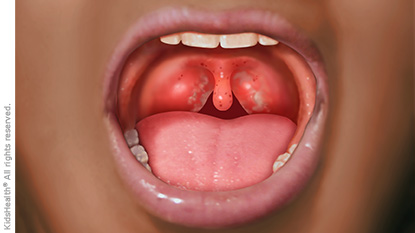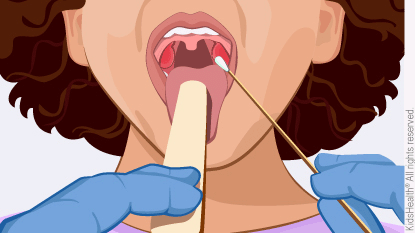- Parents Home
- Para Padres
- A to Z Dictionary
- Allergy Center
- Asthma
- Cancer
- Diabetes
- Diseases & Conditions
- Doctors & Hospitals
- Emotions & Behavior
- First Aid & Safety
- Flu (Influenza)
- Food Allergies
- General Health
- Growth & Development
- Heart Health & Conditions
- Homework Help Center
- Infections
- Newborn Care
- Nutrition & Fitness
- Play & Learn
- Pregnancy Center
- Preventing Premature Birth
- Q&A
- School & Family Life
- Sports Medicine
- Teens Home
- Para Adolescentes
- Asthma
- Be Your Best Self
- Body & Skin Care
- Cancer
- Diabetes
- Diseases & Conditions
- Drugs & Alcohol
- Flu (Influenza)
- Homework Help
- Infections
- Managing Your Weight
- Medical Care 101
- Mental Health
- Nutrition & Fitness
- Q&A
- Safety & First Aid
- School, Jobs, & Friends
- Sexual Health
- Sports Medicine
- Stress & Coping
Strep Test: Throat Culture
What Is a Throat Culture?
A throat culture or strep test is done by using a throat swab to detect the presence of group A streptococcus bacteria, the most common cause of strep throat. These bacteria also can cause other infections (including scarlet fever, abscesses, and pneumonia).
A sample swabbed from the back of the throat is put on a special plate (culture) that enables bacteria to grow in the lab. If bacteria don't grow, the culture is negative and the person doesn't have a strep throat infection.
Explaining the test in terms your child can understand might help ease any fear. During the test, encourage your child to relax and stay still so the health care provider can easily swab the throat and tonsils.
What Is Strep Throat?
Strep throat is a bacterial infection that affects the back of the throat and the tonsils, which become irritated and swollen. It causes a sore throat that's especially painful when swallowing. Your child may get white or yellow spots, or a coating on the throat and tonsils, and the in the neck may swell and become tender to touch.

Why Is a Throat Culture Done?
A throat culture is done to help see whether a child's sore throat is caused by a strep infection vs. other germs (usually viruses) that don't require antibiotic treatment.
Health care providers may do a throat culture if a child:
- has symptoms of a strep throat infection and doesn't have symptoms typical of a viral infection
- has a sore throat and has been exposed to someone known to have a strep throat, or if there are many strep throat cases in the community
How Can I Prepare My Child for a Throat Culture?
Encourage your child to stay still during the procedure so the health care provider can collect a good sample for an accurate test. Be sure to tell them if your child has taken antibiotics recently, and don't have your child use mouthwash before the test, as it may affect test results.
How Is a Throat Culture Done?
Swabbing only takes a few seconds. A health care provider will have your child open their mouth as wide as possible. They might press your child's tongue down with a flat stick (tongue depressor) to clearly examine the mouth and throat. Using a clean, soft cotton swab, they'll lightly brush over the back of the throat, around the tonsils, and over any red or sore areas to collect a sample.
You might want to hold a young child on your lap during the procedure to prevent them from moving around, which could make it harder to get a good sample.

What Should My Child Expect From a Throat Culture?
Your child may feel like gagging when the swab touches the back of the throat. If your child's throat is sore, the swabbing may briefly cause slight pain.
When Are the Results Ready From a Throat Culture?
Throat culture test results are generally ready in 2 days.
What Are the Risks of a Throat Culture?
Throat swabs can be uncomfortable, but there are no risks with a throat culture.
What If I Have Questions About the Throat Culture?
If you have questions about the throat culture, speak with your doctor.

© 1995- The Nemours Foundation. KidsHealth® is a registered trademark of The Nemours Foundation. All rights reserved.
Images sourced by The Nemours Foundation and Getty Images.
